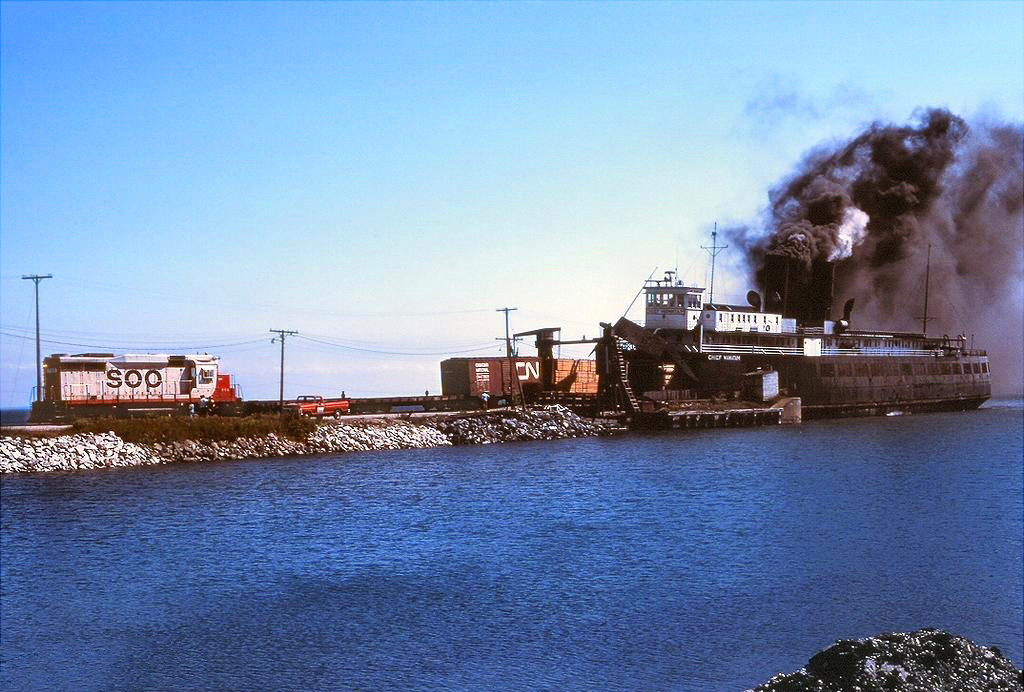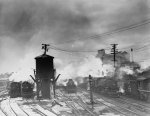Car Ferries: A Once Common Railroad Practice
Published: January 31, 2025
By: Adam Burns
Car ferries occupy an intriguing niche within the wider landscape of transportation and industrial history. These vessels, designed to carry railroad cars across bodies of water, represent a vital solution to connecting disparate rail networks.
During the very early years of railroading - predominantely during the mid-19th century - ferries could be found in service across many rivers of notable size as bridges had yet to be constructed.
By the 20th century ferries had transitioned into much more organized and isolated operations due to their expense and absolute need.
Notable operations through the mid-20th century include locations such as the New York Harbor, San Francisco Bay, the Great Lakes, and Puget Sound.
This article explores the history, technology, and legacy of car ferries, providing a comprehensive understanding of their impact on trade and infrastructure.
 Soo Line GP30 #708 loads the "S.S. Chief Wawatam" at the St. Ignace, Michigan docks during June of 1979. This service was provided in conjunction with the Detroit & Mackinac via Mackinaw City. Rob Kitchen photo.
Soo Line GP30 #708 loads the "S.S. Chief Wawatam" at the St. Ignace, Michigan docks during June of 1979. This service was provided in conjunction with the Detroit & Mackinac via Mackinaw City. Rob Kitchen photo.Historical Context and Development
The concept of ferrying railroad cars across water is rooted in the larger narrative of industrial expansion during the 19th and early 20th centuries. As railroads began to crisscross continents, geographical barriers such as lakes, rivers, and straits presented significant logistical challenges. The burgeoning demand for the efficient movement of freight and passengers necessitated innovative approaches to bridge these divides.
The earliest recorded railroad car ferry was the Leviathan, which began service in 1836, on the Susquehanna River in Pennsylvania. Although manually powered, it set a precedent for the potential of railroad car ferries.
The practice became more widespread with the advent of steam power. Notable developments included the Great Western Railway's use of paddle steamers for car ferry operations between Bristol and Ireland.
The actualization of railroad car ferries escalated rapidly with advances in steamship technology and engineering. By the late 19th century, car ferries were pivotal in connecting vast industrial regions.
Ubiquity was achieved, particularly in North America and Europe where these vessels became integrated into the transportation matrix, linking rail networks that might not have otherwise converged.
Technical and Engineering Considerations
From an engineering perspective, railroad car ferries are marvels of ingenuity. The designs needed to account for both maritime and rail transport dynamics, necessitating robust structures to ensure seamless integration. Key features included strong, stable hulls capable of supporting heavy loads, and tracks laid directly into the deck to facilitate easy railcar movement on and off the vessel.
Several engineering challenges had to be addressed to allow for safe and efficient operation. Loading and unloading required the construction of specialized dock facilities and ramps. Fluctuating water levels meant builders had to ensure ramps maintained alignment with the shore tracks. Thus, adaptability to tidal changes was a critical element of port and vessel design alike.
Furthermore, the car ferry must ensure stability without sacrificing speed or maneuverability. Balancing these factors is crucial, as the dispersion of weight by several rail cars needs careful management to avoid capsizing risks. This has led to the deployment of multi-segment platforms and methods for distributing load over a more extensive surface area.
Geographic Reach and Impact
The North American Scene
In North America, railroad car ferries became particularly prominent. One of the quintessential examples is the SS Badger, which served the Great Lakes region, covering routes between Michigan and Wisconsin.
The Badger, as a coal-fired vessel capable of transporting entire trains, serves as a tangible remnant of the golden age of rail car ferries, connecting economic centers and enabling cross-lake rail accessibility that epitomized regional development.
It was owned by the Chesapeake & Ohio Railway and entered service on March 21, 1953. The Badger continued to operate in service until July 1, 1983 when then-Chessie System discontinued all car ferry services.
Today, it continues to run as an active museum between Ludington, Michigan, and Manitowoc, Wisconsin. The last coal-fired vessel still in service on the lakes the ferry was designated a National Historic Landmark on January 20, 2016.
The East Coast witnessed the proliferation of these ferries as well, notably in New York Harbor, where they played a crucial role in bridging lines across the bustling metropolis and its surrounding areas.
This operation was an essential component of the grand tome of eastern seaboard logistics. One particularly notable company was the Brooklyn Eastern District Terminal which operated expansive freight car ferries throughout New York Harbor.
European Integration
In Europe, railroad car ferries had widespread reach, particularly in Scandinavia and the British Isles. The famed "train ferries" of the late 19th and early 20th centuries connected the UK with the continent, aiding in freight transfer across strategic chokepoints like the English Channel and the Baltic Sea. These ferries often formed part of grander national transport policies, facilitating the movement of goods within expanding empires and beyond burgeoning frontiers.
The Broader Global Context
On a wider scale, railroad car ferries also played roles beyond North America and Europe. The rail-ferry service between Japan's Hokkaido and Honshu is a prime example. These vessels allowed resource and passenger flows, critical for regional continuity, playing considerable roles in the economic knitwork of post-war Japan.
Evolution and Transition
While the golden age of railroad car ferries peaked in the early to mid-20th century, their prominence declined with the rise of faster and more versatile transportation methodologies.
The advent of containerization, improved road networks, and advancements in bridge-building technology steadily reduced reliance on traditional railway networks and their ferried extensions.
Despite this shift, some ferries have endured, primarily due to geographical or infrastructural impediments that remain insurmountable for traditional rail bridges or tunnels. These vessels are a testament to the adaptability and lasting significance of the concept.
Technology has evolved drastically; however, some locations have continued upgrading their facilities and vessels, taking advantage of modern engineering to prolong utility. The introduction of diesel-electric power sources, reinforced hulls, and automated loaing systems are among developments keeping car ferries relevant.
Environmental and Economic Implications
Economically, railroad car ferries have long been synapomorphic in maintaining vital links across water bodies, particularly in aiding trade within decentralized, transnational economies. They played a cornerstone role in local and regional economic integration, oftentimes linking remote locales to larger commercial hubs.
When it comes to environmental considerations, railroad car ferries historically created less pollution compared to their more direct infrastructure alternatives, such as tunnels or bridges requiring significant alteration to landscapes. However, traditional models relied on coal and steam setups, necessitating transitions with considerations for regulations and sustainable practices.
Today's environmental considerations are inextricably tying into how any remaining operations progress. For some, converting to greener fuel options to meet contemporary standards might determine survival viability.
Cultural and Sociological Perspectives
Beyond the tangible assets and functional contributions of railroad car ferries, they have carved out niches of cultural significance, tied to regional identities as embodiments of historical progression and industrial prowess. Cultural commitments have been particularly noticeable in areas where ferry services provided not only economic benefits but also community connectivity.
In certain locations, these ferries have gained preservation status, serving as floating museums, educational platforms, and tourist offerings – reinforcing their continued imprint beyond industrial utility. They are emblematic of how human innovation can conquer natural constraints through collaborative networks of infrastructure and creativity.
Continuing Relevance
The narrative of railroad car ferries is one woven deeply into the fabric of industrialization. Despite their gradual decline from mainstream infrastructure solutions, their legacy persists in historical reverence and in some limited ongoing applications.
These ferries stand as enduring symbols of ingenuity, bridging disparate geographical regions while fostering economic exchanges that helped develop nations.
In an age where connectivity continues to drive progress, and environmental considerations increasingly dictate infrastructural approaches, the lessons learned from the evolution of railroad car ferries offer insight into balancing human mobility needs with the natural world.
They remain vivid reminders of the intersecting histories of technological advancement, commercial enterprise, and cultural narratives that define the modern age of transportation.
Recent Articles
-
Savannah Union Station: The City's Elegant Terminal
Jan 31, 25 11:40 PM
Savannah Union Station was the city's opulent rail terminal that served multiple railroads from 1902 until 1962. -
The Parlor Car: Providing First-Class Service
Jan 31, 25 11:17 PM
The parlor car was an early first-class passenger car that appeared in the mid-19th century. They became more widespread during the 20th century but declined after World War II. -
Pavonia Terminal: Erie's Jersey City Station
Jan 31, 25 11:01 PM
Pavonia Terminal was the Erie Railroad's primary passenger station located in Jersey City, New Jersey. It operated from 1861-1958.


